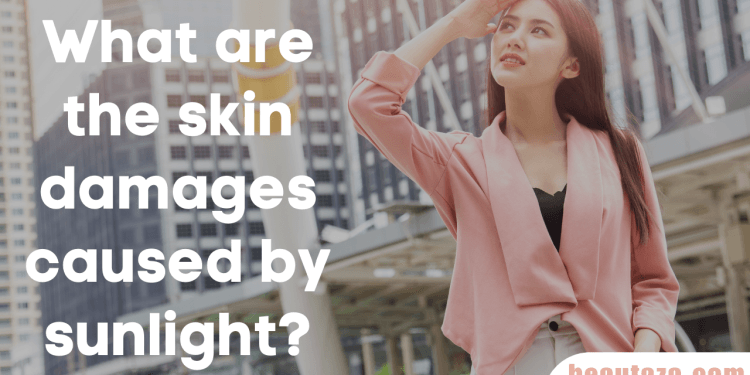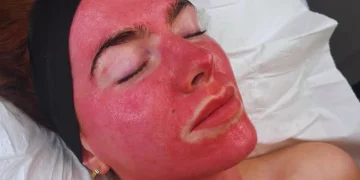
I will discuss What are the skin damages caused by sunlight? in this blog post. The warmth of the sun’s rays on our skin is a sensation most of us cherish. It invigorates us, lifts our spirits, and provides the energy necessary for life on Earth. Yet, beneath the surface of this seemingly benevolent relationship between sunlight and human beings lies a complex interaction that warrants our attention and understanding. While sunlight offers essential benefits, it can also pose significant risks to our skin health. This comprehensive guide will delve into the intricate world of skin damage caused by sunlight, shedding light on the science behind these effects and unveiling the importance of safeguarding our skin against its potential harm.
Sunlight, composed of a spectrum of ultraviolet (UV) rays, reaches us with life-giving potential and potentially detrimental consequences. Our skin, the body’s largest organ, acts as a shield between our internal systems and the external environment. As such, it encounters the full force of sunlight’s power, absorbing its energy and responding uniquely. This delicate dance between the sun’s rays and our skin can have immediate and long-term effects ranging from superficial discomfort to severe health implications.
The Science of Sunlight and Skin Interaction
At the heart of our exploration into the damages caused by sunlight lies a fascinating and intricate dance between the sun’s rays and the outermost layer of our body – the skin. Though invisible to the naked eye, this interaction is critical to understanding how sunlight can nourish and harm our skin.
Ultraviolet Rays: Unveiling the Spectrum
The sun emits various ultraviolet (UV) rays, each with a distinct wavelength and energy level. The UV spectrum comprises UVA, UVB, and UVC rays, each with varying degrees of penetration into the Earth’s atmosphere and our skin.
- UVA Rays are the longest wavelengths, accounting for most UV radiation reaching the Earth’s surface. While less intense than UVB rays, UVA rays can penetrate the skin’s layers deeply. Overexposure to UVA rays can lead to premature aging and wrinkles and contribute to the development of skin cancer.
- UVB Rays: These medium-wavelength rays are responsible for causing sunburn and directly damaging the DNA in the skin’s cells. UVB rays play a significant role in developing skin cancer and are more intense during peak sun hours.
- UVC Rays: Fortunately, most UVC rays are absorbed by the Earth’s ozone layer and do not reach the surface. However, they possess the highest energy and can harm living organisms.
Penetration and Absorption: A Closer Look
When sunlight encounters our skin, a complex interplay of absorption and reflection begins. The outermost layer of our skin, the epidermis, is home to a pigment called melanin. Melanin is nature’s sunscreen, absorbing and dissipating UV radiation to protect the skin’s deeper layers.
UV rays penetrate the skin and interact with the DNA in skin cells. In the case of UVB rays, this interaction can lead to mutations in the DNA, which can result in the development of skin cancer over time. On the other hand, UVA rays generate free radicals within the skin, contributing to oxidative stress and the breakdown of collagen and elastin fibers. This, in turn, accelerates the aging process and increases the risk of skin cancer.
Immediate Skin Reactions to Sunlight
Immediate Skin Reactions to Sunlight: Unmasking the Unseen Impact
As the sun’s rays grace our skin, an intricate series of reactions unfold beneath the surface, often imperceptible until their effects become evident. These immediate skin responses to sunlight provide valuable insights into how our bodies react to UV radiation and serve as early warning signs of potential damage.
Sunburn: When Skin Turns Red
One of the most recognizable and uncomfortable immediate reactions to excessive sun exposure is sunburn. Sunburn occurs when the skin’s DNA is damaged by UVB rays, triggering an inflammatory response. Blood vessels near the skin’s surface dilate, causing redness, warmth, and tenderness. In severe cases, blistering and peeling can follow.
It’s important to understand that sunburn is not just a temporary inconvenience; it reflects direct damage to the DNA of your skin cells. Repeated sunburns over time significantly increase the risk of skin cancer, emphasizing the importance of sun protection.
Tanning: The Skin’s Defense Mechanism
Tanning, often perceived as a healthy glow, is the skin’s natural defense mechanism against UV radiation. When exposed to UV rays, melanocytes—the cells responsible for producing melanin—ramp up their activity. Melanin, the pigment responsible for skin, hair, and eye color, absorbs and disperses UV radiation, shielding the DNA within skin cells from harm.
Cumulative and Long-Term Skin Damage
Cumulative and Long-Term Skin Damage: The Silent Effects of Sunlight
While immediate skin reactions to sunlight provide visible warnings, the extent of sun-induced damage often reveals itself over time. Cumulative and long-term effects of UV radiation can lead to a range of skin issues that extend beyond the surface, underscoring the importance of consistent sun protection and mindful sun exposure practices.
Premature Aging: Unraveling the Wrinkles and Fine Lines
As the years pass, the effects of chronic sun exposure become increasingly evident, giving rise to the phenomenon known as premature aging or photoaging. UV radiation damages collagen and elastin fibers in the skin, leading to a loss of skin elasticity and firmness. The result? Wrinkles, fine lines, and sagging skin that prematurely age the complexion.
Photoaging is often most noticeable in areas with the most sun exposure, such as the face, neck, and hands. While some aging is inevitable, protecting your skin from excessive sun exposure can significantly slow down the process and help you maintain a youthful appearance.
Hyperpigmentation: The Dark Side of Sunlight
Hyperpigmentation, characterized by the appearance of dark spots or patches on the skin, is another common long-term effect of sun exposure. UV radiation triggers the overproduction of melanin, leading to uneven skin tone and the formation of sunspots, age spots, or melasma (a condition more common in women).
These areas of hyperpigmentation can be stubborn and challenging to treat, often requiring specialized skincare products or professional treatments. Consistent sun protection is essential to prevent further hyperpigmentation and maintain an even complexion.
Actinic Keratosis: A Precursor to Skin Cancer
Actinic keratosis (AK) is a rough, scaly patch that develops on the skin due to prolonged sun exposure. While not cancer, AK is considered a precancerous growth, as it can potentially progress into squamous cell carcinoma if left untreated. AK is commonly found on sun-exposed areas such as the face, ears, scalp, and backs of hands.
Protective Measures and Sun Safety Tips
Armed with a deeper understanding of the potential damages caused by sunlight, we embark on a mission to shield our skin from harm while still enjoying the many pleasures of outdoor life. In this segment, we unravel a treasure trove of protective measures and sun safety tips to help you navigate sun-soaked landscapes with confidence and care.
Sunscreen: Your Skin’s Best Friend
Selecting and applying the right sunscreen is a cornerstone of adequate sun protection. Look for a broad-spectrum sunscreen that shields against UVA and UVB rays, and choose a Sun Protection Factor (SPF) appropriate for your skin type and planned sun exposure. Remember, sunscreen should be reapplied every two hours, even on cloudy days and after swimming or sweating.
Protective Clothing: A Stylish Barrier
Clothing provides a physical barrier between your skin and the sun’s rays. Opt for lightweight, long-sleeved shirts, wide-brimmed hats, and sunglasses with UV protection to shield your face and eyes. Some clothing even comes with Ultraviolet Protection Factor (UPF) ratings, indicating their ability to block UV radiation.
Seeking Shade: A Cool Respite
When the sun is at its zenith, seek refuge in the shade. Not only does shade offer immediate protection, but it also reduces overall sun exposure, helping to prevent the cumulative damages that occur over time.
Timing is Everything: Be Sun-Wise
Avoid unnecessary sun exposure during peak hours, usually between 10 a.m. and 4 p.m., when UV radiation is vital. If you plan to be outdoors, schedule activities earlier or later in the day to minimize your exposure.
Lifestyle Choices: Sun-Savvy Behavior
Engage in outdoor activities that minimize direct sun exposure, such as hiking in shaded areas or enjoying beach time under an umbrella. Embrace sun-protective behaviors like wearing a rash guard when swimming or using a beach tent for added shade.
Hydration and Skincare Routine: Inner and Outer Care
Staying hydrated is essential for maintaining healthy skin, especially when exposed to the sun’s heat. Incorporate a nourishing skincare routine with moisturizers, antioxidants, and products that soothe and repair sun-exposed skin.
Read –














